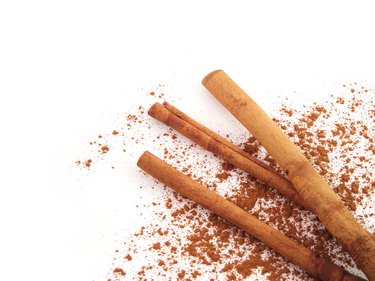
Cinnamon is a popular aromatic spice, available already ground as well as in stick or "scroll" form. You can find either version of cinnamon in your supermarket's spice aisle, at your local health food store or at a market specializing in Asian or Mexican cuisine.
The rolled-up cinnamon sticks are formed from the inner bark of the Cinnamomum verum tree native to Sri Lanka. That is where "true" cinnamon (i.e., Ceylon cinnamon) comes from. Surprisingly, most cinnamon used in the United States is the similar spice cassia – less subtle in flavor and cheaper to produce – also known as Chinese cinnamon.
Video of the Day
Video of the Day
Ceylon Cinnamon vs. Cassia
Ceylon cinnamon bark is softer than the hard, tough cassia bark. It's also lighter in color and is composed of several very thin layers rather than a single layer. When deciding which one to use, be mindful of the dish in which you intend to use it.
The subtle, sweet flavor of Ceylon cinnamon is delicious in sweets and desserts. The bolder taste of cassia can be used to advantage in more savory dishes or as part of a complex sauce for meaty meals.
In any case, it's best to grind only the cinnamon you're going to use and keep the remaining sticks in a tightly-closed container. Normally, cinnamon sticks retain their potency for three years or so, but bear in mind that the supermarket where you bought them might have had them on the shelf for almost that long.
Homemade Cinnamon Powder
You can grind cinnamon sticks in a mortar and pestle, but it's a very labor-intensive method, especially if you're working with the dense, tough cassia bark. Ceylon cinnamon is softer but still is not grated easily by this method. Applying pressure as you might, you could still wind up with shards and strings instead of usable homemade cinnamon powder.
Other manual techniques include using the fine-grade side of a box grater or a microplane zester/grater – a narrow, wand-like tool with very sharp grating blades. To use a microplane, hold it at an angle on your countertop while bearing down on it for stability as you grate. Cassia sticks in particular tend to be brittle, so be extra careful so they don't break into shards.
There's also a grater out there that is specifically made for cinnamon, according to its manufacturer. Cinnamon Hill is a cinnamon-centric company from which you can order fresh sticks as well as other cinnamon-related products. Their grater is similar to a microplane, but it's quite a bit broader, with a curved surface that is securely mounted on its base. As an added bonus, you can get samples of the company's fresh cinnamon sticks along with the grater.
Using Electric Grinders
A cook who plans to grind her own spices or herbs on a regular basis should look into investing in a dedicated spice grinder. An electric coffee grinder will often do the trick, but make sure the manufacturer specifies that the grinder will also work for spices. Ideally, the grinder should be up to the task of grinding nuts and seeds as well. You will need a separate grinder for your spices. Do not use the same grinder for both spices and coffee.
There are also a number of electric grinders on the market that are made specifically for spices, herbs, nuts and seeds. Some of them come with separate wet and dry blade attachments so you can grind moist ingredients such as ginger as well as dry ingredients like cinnamon. Good electric spice grinders start at around $30 and are well worth the price.
When to Skip the Grinding
You may not even think of using cinnamon in its basic stick form, but that's all you need for many flavorful drinks. Break the stick in half lengthwise, make sure the edges are cleanly severed, add to the drink and let that spicy flavor seep into the liquid. Take note that this is one case where you definitely do not want ground cinnamon muddying up the works.